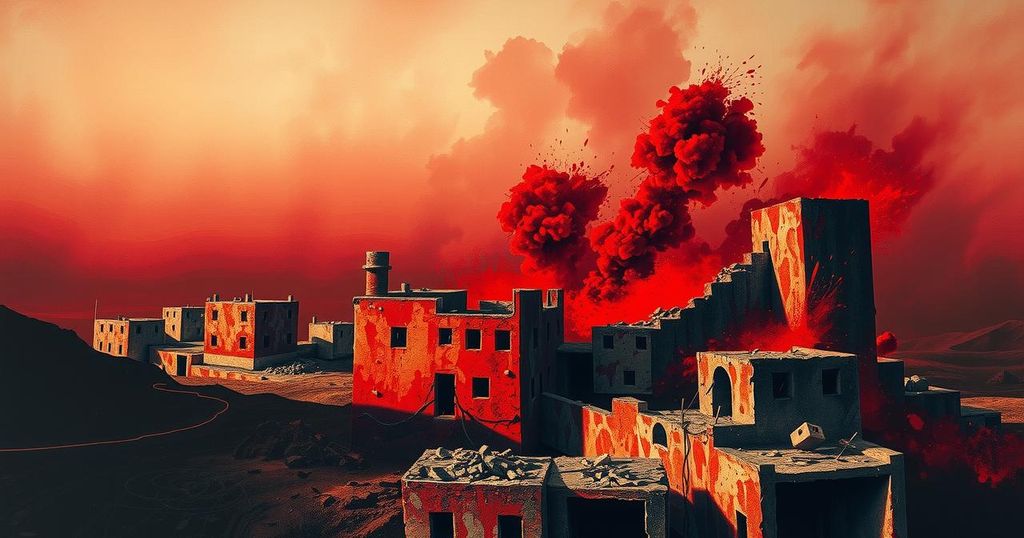The Ongoing Struggle in Sudan: Dynamics of War and Humanitarian Crisis
Sudan has been in a civil war since April 2023, driven by military factional struggles. With an estimated 30 million civilians needing aid, the conflict has resulted in severe humanitarian crises, widespread displacement, and a significant death toll. External military support has complicated peace efforts, raising concerns about regional stability. An urgent call for civilian protection and effective peacekeeping measures remains unmet.
Since April 15, 2023, Sudan has been embroiled in a devastating civil war, primarily between the Sudanese Armed Forces and the paramilitary Rapid Support Forces. This conflict arises from long-standing struggles over military control and integration. Despite international mediation efforts, a solution remains elusive, leading to one of the world’s worst humanitarian crises, affecting approximately 30 million civilians who require assistance.
The ongoing violence has resulted in widespread humanitarian emergencies, marked by attacks, rampant looting, and the destruction of essential infrastructure. Citizens are increasingly deprived of medical care, experiencing severe food shortages and a collapsing economy. This turmoil has also precipitated a significant displacement crisis, with over 14 million individuals forced to abandon their homes, seeking refuge within and outside Sudan.
Currently, estimations of the death toll vary from 20,000 to 62,000, though the true number may be considerably higher. The prolonged conflict reveals no clear resolution and has emerged as a priority concern for the global community. Academic researchers continue to document the war’s implications meticulously since its inception in 2023.
Both primary factions possess sufficient weaponry to sustain their conflict, with Sudan ranking second in the region for firearm proliferation. Research indicates that while the Sudanese Armed Forces benefit from air superiority and substantial ground assets, the Rapid Support Forces operate with agile units equipped predominantly with lighter weaponry. This balance of military capabilities contributes to the intensity of ongoing hostilities.
External interventions have intensified the conflict, with countries such as Chad, Egypt, Iran, Libya, Qatar, and Russia providing varying degrees of support to the factions. Notably, Saudi Arabia and the United Arab Emirates have pivotal interests; their backing has deepened internal divisions since they established relationships with opposing leaders, further entrenching the military standoff.
International involvement has altered regional dynamics, evidenced by accusations from the Sudanese army alleging weapon supplies to the Rapid Support Forces from the UAE via Chad. Such claims risk broadening the conflict, as Sudan’s borders encompass several unstable nations including Chad and South Sudan; economical and social destabilization is a pressing concern.
The ongoing strife has left millions of civilians endangered. A recent UN report advocated for an independent protective force, a proposal Sudan’s officials have dismissed. With the absence of both a peacekeeping force and international oversight since early 2024, calls for a dedicated peacekeeping role to create safe zones for civilians have gained traction.
Despite multiple attempts at peace negotiations facilitated by the African Union and the UN, achieving a lasting ceasefire has proven difficult, especially amid competing interests from nations involved in the discussions. Continuous external military support to combatants undermines peace efforts, perpetuating hardship for the civilian population.
In summary, the civil conflict in Sudan, which has persisted since April 2023, has led to a severe humanitarian crisis affecting millions. Both military factions are well-armed, and external influences exacerbate the situation, straining regional stability. The urgent need for a protective force for civilians remains unmet, while peace efforts have thus far yielded insufficient results. Without a strategic redirection in international and regional interventions, the cycle of violence is projected to continue, further complicating the plight of Sudan’s population.
Original Source: theconversation.com








Post Comment